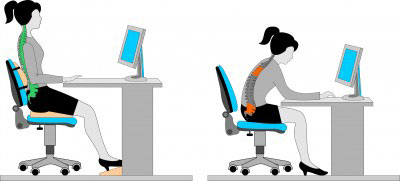In today’s competitive workplace, complaining of a backache
is tantamount to bellyaching. A tension headache can be a
temporary headache caused by tightening of the muscles in
the mid-back and neck. Sitting for long periods of time may
in fact lead to recurring pain everyone should take heed of.
In order for less stress to be placed on muscles and joints,
you need to have good posture. The goal of good posture is
to maintain the three natural curves of the spine in the
normal, balanced alignment. To keep your spine aligned, you
need strong, flexible muscles to hold your spine in
position. Then, by learning how it feels to be in good
posture, you’ll develop the body awareness that helps you
stay in good posture throughout the day, no matter what
you’re doing.
Your spine has three natural curves: the cervical curve of
the your neck, the thoracic curve of your middle back, and
the lumbar curve of your lower back (lordosis). To test
whether your three curves are in their natural alignment,
imagine a plumb line beside your body. If your ears,
shoulders, pelvis, knees, and ankles line up on the plumb
line, your three curves are in the correct position.
Posture exercises give you the strength and flexibility you
need to maintain your spine’s three natural curves. Strong
muscles hold the bones and joints of your spine in good
alignment. Flexible muscles won’t pull your bones and joints
out of line. A Physical Therapist can instruct you on proper
posture exercises designed to strengthen and lengthen
specific muscles. Here are a few common exercises Physical
Therapists prescribe:
Hamstring
Stretch, Hip Flexor Stretch,
Curl Up,
Kneeling Arm and Leg Extension
The body also needs variety and movement to function
properly. When we sit, certain muscles remain contracted. If
you maintain that position for a long time, the muscles lose
their elasticity and tighten, putting strain on joints.
Also, a big problem with sitting comes from the fact that
your low back if pulled out of its natural position when you
place your legs at a 90-degree angle to your hips. Studies
show that when you drop into a chair, your hips stop
rotation after the first 60 degrees of descent. “To move
your legs the final 30 degrees into position, the muscles of
the back of your thighs pull the bottom of your pelvis
forward to tip it backward,” says Galen Cranz, Ph.D., a
professor of architecture at the University of California at
Berkley and the author of The Chair. “That”, says Cranz,
“flattens the lumbar curve.” Therefore, people who sit a lot
tend to have shortened hip flexors and hamstrings. When we
stand up, those tightened muscle groups put stress on the
pelvis and low back. This can lead to chronic problems like
a herniated disc.
The best advice is to get up from the chair and walk around.
However, if a heavy workload has you chained to your desk,
using proper posture and learning some simple stretching
techniques can help. Bad habits, like slouching and crossing
your legs, contribute to tension headaches and neck,
shoulder and low back pain.
Here are some general guidelines for proper sitting posture:
• Maintain the normal curves of your spine – Do not sit
slumped or bent forward. Use a cushion or rolled towel if
your chair does not provide adequate support for your lower
back
• Place feet comfortably on the floor or footrest – The
chair should not dig into the back of your knees. Your feet
should rest on the floor or footrest and not dangle.
• Knees and hips and elbows should be bent at a right (90
degree) angle
• Sit close to your work – Locate frequently used materials
within arm’s reach. This will help you avoid awkward
movements and excessive reaching, bending or twisting of
your spine.
• If you have limited legroom, try sliding forward on the
chair slightly and lowering your knees – This will allow you
to get closer to your work. Also, use a cushion or towel
roll for added low back support. This position is not
recommended for extended periods of time because it
increases pressure on the back of the legs.
• Perform some of your work standing, if the job permits –
This can reduce some of the pressure on your back
• Keep a good sitting posture while driving – Keep the seat
close to the steering wheel. Use a small cushion or pillow
for additional support to your low back.
|
 |
Stretching every hour or two is also a good strategy to
preventing back pain from sitting too long. Hold each of
these stretches for a minimum of 20-30 seconds and do
several repetitions.
• chin tuck
• shoulder blade squeezes
• seated Hamstring stretch
So now that you know about good posture, what will you do?
It’s quite simple. Respect the spinal curves. Use these good
strategies and you will be on your way to a healthy spine.
Last revised: July 18, 2011
by Jennifer Hill, MPT, CSCS






